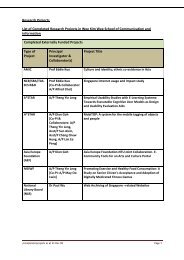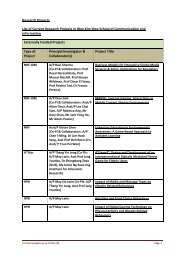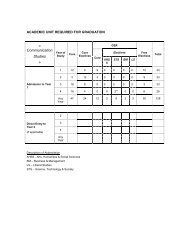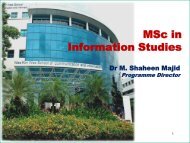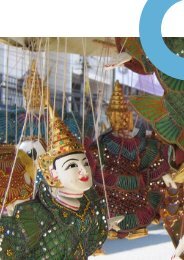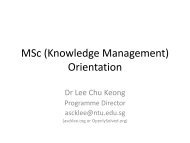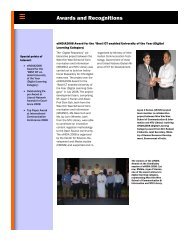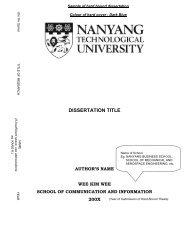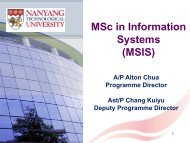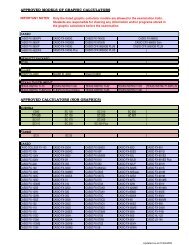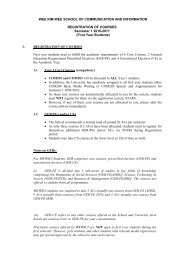Programme and Abstracts 4 Oct 2011 - WKWSCI Home - Nanyang ...
Programme and Abstracts 4 Oct 2011 - WKWSCI Home - Nanyang ...
Programme and Abstracts 4 Oct 2011 - WKWSCI Home - Nanyang ...
You also want an ePaper? Increase the reach of your titles
YUMPU automatically turns print PDFs into web optimized ePapers that Google loves.
Conference on Film <strong>and</strong> Cinema in Singapore (6‐7 <strong>Oct</strong>ober <strong>2011</strong>)<br />
Jointly organised by Wee Kim Wee School of Communication <strong>and</strong> Information, <strong>Nanyang</strong> Technological University <strong>and</strong><br />
Asia Research Institute, National University of Singapore<br />
CULTURAL MAPPING OF SINGAPORE CINEMAS<br />
CHARLES LEARY<br />
Faculty of Applied & Creative Arts, University of Malaysia Sarawak<br />
charley.leary@gmail.com<br />
The main objective of this project is to document the diversity of film exhibition <strong>and</strong> spectatorship in<br />
Singapore. This distinctive quality of different spaces for film exhibition are qualified, for instance, by the<br />
variety of language of films shown <strong>and</strong> the ethnicity of the audience, as well as by the format <strong>and</strong><br />
architecture. Today, most cinemas show Hollywood films in English or films from Hong Kong dubbed into<br />
M<strong>and</strong>arin. There are of course also exceptions, but until the 1970s, one could regularly find a number of<br />
theatres showing films in Malay as well as in different Chinese dialects.<br />
Singapore has employed a variety of physical structures for film exhibition. The Cathay Cinema, for<br />
example, was housed in the Cathay Building, the seat of power for the Cathay Organisation <strong>and</strong> a<br />
Singapore l<strong>and</strong>mark. Singapore film culture featured more informal spaces for film viewing as well. For<br />
example, mobile film units would travel to the kampongs to project films in communities with less access<br />
to the picture palaces. Another unique site, not nearly as prevalent in other major world cities, is the openair<br />
cinema, some of which were permanent structures while others temporary. Today, many of the picture<br />
palaces <strong>and</strong> st<strong>and</strong> alone cinemas are gone, <strong>and</strong>, with the arrival of the Golden Village Corporation in 1992,<br />
Singapore became the first country in Asia to adopt the multiplex configuration for cinema architecture<br />
that has come to dominate the space of film‐going across the world.<br />
I aim to produce a map identifying the locations of cinemas <strong>and</strong> other sites of film exhibition (including,<br />
where appropriate, tracing the typical routes of mobile cinemas), both extant cinemas <strong>and</strong> those no longer<br />
in operation. A Geographic Information System (GIS) has been utilized to investigate spatial patterns<br />
emerging in the location of Chinese temples in Singapore (Dean 2010), <strong>and</strong> I hope to implement a similar<br />
approach in considering variables such as language dominating the particular cinema, corporate holdings,<br />
proximity to housing estates or kampongs, ethnic makeup of neighborhoods, <strong>and</strong> networks between<br />
formal <strong>and</strong> informal spaces. UNESCO, for example, has embraced cultural mapping <strong>and</strong> the use of GIS to<br />
value tangible <strong>and</strong> intangible cultural heritage in local communities. Although this approach has more<br />
frequently been used to study pre‐modern cultures, cultural mapping provides the recognition of cultural<br />
diversity <strong>and</strong> this specific film heritage in Singapore, <strong>and</strong> can also elucidate cultural policy <strong>and</strong> urban<br />
planning as Singapore continues its “Renaissance City” project in encouraging creative zones in a “global<br />
media city.” (Kong 2009).<br />
Charles Leary (PhD, New York University) is Associate Professor in the Cinematography <strong>Programme</strong> at the<br />
Faculty of Applied & Creative Arts, University of Malaysia Sarawak. He is currently working on a manuscript<br />
on the Cold War politics of Hong Kong film culture. He was previously a Postdoctoral Fellow at the Asia<br />
Research Institute, National University of Singapore.



